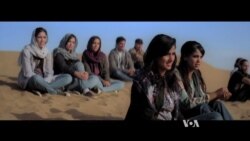Iranian Afshin Ghaffarian dreams of becoming a dancer from a young age. He hacks into YouTube and watches dancers like Michael Jackson and Rudolf Nureyef. But dancing is illegal in the Islamic Republic.
Desert Dancer by filmmaker Richard Raymond is based on the true story of Ghaffarian and his friends, who form an underground dance troupe in an abandoned building. Elaheh is the troupe's lead dancer. Schooled secretly by her ballerina mother, she helps choreograph sequences that criticize the regime. Afshin and his team decide to perform in front of a small audience in the desert, the only place untouched by Iran’s military police, or so they think. The police catch them and arrest Afshin, who, through sheer luck escapes. But his life in Iran becomes untenable so he defects to France.
“Our country is like two parallel worlds. It’s the one you see outside, and then is this world behind closed doors. In here we are free!” relates Afshin’s Iranian arts teacher in Desert Dancer.
His remarks set the stage for the film which draws the curtain on Iran’s secret world where young Iranians party, wear Western clothes and dance away from the prying eyes of the Iranian police.
Freedom of expression
Desert Dancer is the archetypical narrative of freedom of expression against tyranny. The dialogue is trite but the dance sequences between lead actors Reece Ritchie and Freida Pinto convey deeply the pain and suffering of oppressed Iranians.
Other films have used dance for similar narratives.
One of them, is the 1980s drama White Nights, where accomplished Soviet dancer Nikolai Rodchenko, played by classic ballet dancer Mikhail Baryshnikov, plans his defection. In the film, one dancing sequence in particular, which Rodchenko performs in private at the Kirov Theater in Moscow, exudes his pain and frustration against Soviet totalitarianism.
Dance is also the main feature in the 2012 film Step Up Revolution. Here again, the narrative is straightforward. Underprivileged American youth use dance as a form of protest against a wealthy businessman who wants to develop their historic neighborhood. The explosive dance sequences express the fight against social injustice and elevate this otherwise lackluster film.
Communicating through dance
But what is it about dance that rises above words and connects with audiences?
Choreographer Kimmie Dobbs, the founder of DEVIATED THEATER, a dramatic movement company in Washington D.C., says dance is its own form of communication.
"There is a part of dance that speaks just directly, just viscerally to the emotions, to the subconscious," she said.
Dobbs illustrates how in her recent production called Creature, movement evokes a powerful and haunting imagery of a post-apocalyptic world, destroyed by climate change.
“As long as there is intention behind the movement and it’s committed, it’s going to communicate," she said.
This is definitely the case in films such as Desert Dancer, where dancing upstages the words and becomes the narrative.






